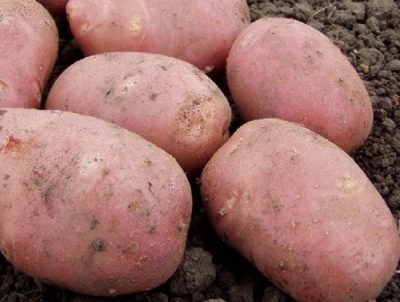
- Authors: Leibniz Institute of Plant Genetics and Crop Plant Research (Germany)
- Name synonyms: Berlichingen, Berlichingen
- Appointment: universal
- Tuber weight, g: 80 -150
- Peel color: red
- Color of the pulp: white
- Starch content,%: 14 -17%
- Tuber shape: oval
- The soil: unpretentious
- Keeping quality: high
In the 80s of the XX century, the Berlinka potato variety was very popular, which was distinguished by good yield, unpretentiousness to the soil and climate, and excellent taste. From this variety, which was well preserved throughout the winter period, it was possible to prepare various tasty and nutritious dishes. The variety retains its presentation for a long time and is suitable for growing not only for personal consumption, but also for sale.
Breeding history
The Berlichingen potato variety was developed by German breeders in 1923 by crossing the Pepo and Centriol varieties. In the USSR, he came to the 80s and was very popular in various regions of the country due to the unpretentiousness of the variety to soils and climatic conditions. The variety was actively grown on an industrial scale, but in the 90s of the last century it was replaced on large farms with new varieties that were more resistant to viral diseases.
Description of the variety
German-bred Berlink potatoes belong to mid-season varieties, in which ripening begins after the end of flowering. Growth time is 90 to 110 days from planting.
One bush yields 7 to 12 tubers covered with red skin. The potato has a white flesh, which contains from 14 to 17% starch, which makes it a medium starch variety. The average yield reaches 220 centners per hectare.
Characteristics of the appearance of the bush and root crops
The aerial part of the Berlink potatoes forms tall leafy bushes with green leaves, on which there are purple dots in the leaf axils. The size of the leaves is small. They have a matte finish.
During the flowering period, Berlinka forms sprawling inflorescences with a large number of elongated flowers, which are distinguished by a small calyx, have purple or red-purple corollas, on which internal doubleness can form. Inside the flower there is an orange anther.
At the end of flowering, berries are formed in the inflorescences. The foliage lodges in the final growing season.
Ripe potato tuber has an oblong shape with blunt tops. On average, the weight of one tuber can reach 80-150 g. Berlinka's peel is dense and red with small dark red eyes. After the dug out tuber dries up, the skin begins to peel off.
The pulp of this variety is white or light yellow. In a mature Berlinka, the flesh does not oxidize on the cut and remains white. Overripe tubers are characterized by the formation of dark rings on the cut.
Purpose and taste of tubers
Berlinka potatoes are universal table varieties that can be used with any cooking technology:
cooking;
frying;
baking.
During cooking, this potato variety develops a specific potato flavor. Under the influence of temperature, the white pulp darkens slightly. The Berliner pulp is moderately watery. If the amount of starch exceeds the norm, it may crack.
In some cases, it is allowed to use Berlinka for agricultural purposes - as animal feed.
Maturation
Berlinka potatoes are medium-late varieties. The time from the moment of sowing in the ground to harvesting is from 90 to 110 days.
Yield
This variety, tested by more than one generation of gardeners, has a good yield.At a seeding rate of 400 tubers per one hundred square meters of Berlinka, it gives from 220 to 400 centners per hectare.
Growing regions
Berlinka was zoned in the Soviet Union for cultivation in the regions of Western Siberia. It is also suitable for northern regions with short summers, where it is grown as an early ripening variety due to the ability of early tuber formation.
Growing and caring
Berlinka potatoes are a versatile variety suitable for traditional and non-traditional cultivation:
under a shovel in the open field on the field;
under the film;
Dutch method;
under the straw;
in trenches;
in mounds or in ridges.
The soil for planting is prepared in the fall, carefully digging up the area by hand or with the help of a tractor. During the autumn digging, fertilizers are applied to the soil. Mineral complex additives, as well as urea and humus, are added without fail.
In the spring, you do not need to dig up the soil to retain moisture in it. In the spring, when planting potatoes, recesses or elevations into which the seed is laid out are created using a bayonet shovel or walk-behind tractor. For sowing, small tubers weighing 70-80 g are used.

Planting potatoes is one of the main spring activities traditional for Russian gardeners. There are many ways to plant this vegetable, allowing you to get a good harvest in different conditions and climates. Before planting, you need to carefully prepare the planting material, correctly determine the timing, competently prepare the soil.



Disease and pest resistance
Berlinka is notable for its instability to various viral infections, and first of all to late blight, which affects the tubers and leaves of the plant, as well as to the formation of ring rot. The variety does not suffer from potato cancer and is relatively resistant to rhizoctonia and scab.
Requires special treatment from pests, including the Colorado potato beetle.

Potatoes are a popular vegetable crop that many gardeners planted on their site. But growing a bountiful harvest of tasty and large tubers is unlikely to succeed if the beds are not properly protected from the most common diseases and pests. Often, the development of diseases of various etiologies of potatoes goes unnoticed, so it is important to identify the problem in time and eliminate it.
















































































